As a critical material in the power and electronics sectors, the performance of silicon steel heavily relies on the precise control of its production processes. The following analyzes its manufacturing flow through six core stages:
1. Raw Material Screening and Pretreatment
Silicon steel production begins with high – purity iron sources (iron ore or scrap steel) and ferrosilicon alloys. Iron ore undergoes beneficiation and sintering to enhance purity, while scrap steel is strictly sorted to remove impurities containing harmful elements like copper and zinc, which could degrade the magnetic properties of silicon steel. Raw materials are mixed in preset chemical ratios using precise weighing systems, with trace elements such as aluminum and manganese added to optimize performance, laying the foundation for smelting.
2. Precision Smelting at High Temperatures
Mixed raw materials are smelted in electric arc furnaces or converters, with strict control over temperature, time, and furnace atmosphere. Impurities like sulfur and phosphorus are removed via redox reactions. Techniques such as oxygen top – blowing and vacuum decarburization reduce carbon content in the molten steel. The timing and quantity of silicon addition are precisely regulated to ensure uniform distribution. Post – smelting, rapid on – line analysis detects molten steel composition; adjustments are made if unqualified, and qualified steel proceeds to the next stage.
3. Continuous Casting and Primary Rolling
Qualified molten steel is transported to continuous casting machines, where it solidifies in molds. Parameters like casting speed and cooling intensity directly impact billet quality, requiring strict control to avoid defects such as cracks and shrinkage cavities. Cast billets are reheated and then rolled in primary mills through multiple passes to reduce thickness and improve internal density, preparing them for cold rolling.
4. Cold Rolling for Deep Processing
Cold rolling is a pivotal step to enhance silicon steel performance. Multi – stand continuous rolling mills gradually reduce thickness, refining grains and improving surface quality and magnetic properties. Precise control of rolling force, speed, and tension prevents issues like poor strip shape and surface scratches. For oriented silicon steel, a secondary recrystallization process is used, guiding grain growth along specific directions via controlled rolling and annealing to significantly enhance magnetic permeability.
5. Performance Optimization via Annealing
Cold – rolled silicon steel undergoes annealing to eliminate work hardening and optimize magnetic properties. Intermediate annealing (during cold rolling) restores plasticity for subsequent processing, while final annealing achieves the target magnetic properties and microstructure. Annealing under hydrogen – protected atmospheres prevents oxidation, promotes grain growth, and develops texture, reducing hysteresis and eddy current losses while enhancing permeability.
6. Surface Coating and Finishing Packaging
Annealed silicon steel is coated with inorganic, organic, or semi – organic insulating layers via roll coating or spraying, which are then dried to form dense protective films, reducing eddy current losses and rusting. Finishing processes like shearing, leveling, and straightening ensure dimensional accuracy and strip shape compliance. Finally, products are packaged in moisture – and rust – proof materials for storage and transportation.
The silicon steel production process is highly complex and precise, with minor variations in any stage affecting final performance. Continuous technological advancements drive the development of new processes and equipment, continuously upgrading silicon steel properties to meet the growing demands of high – end power and electronics applications.

